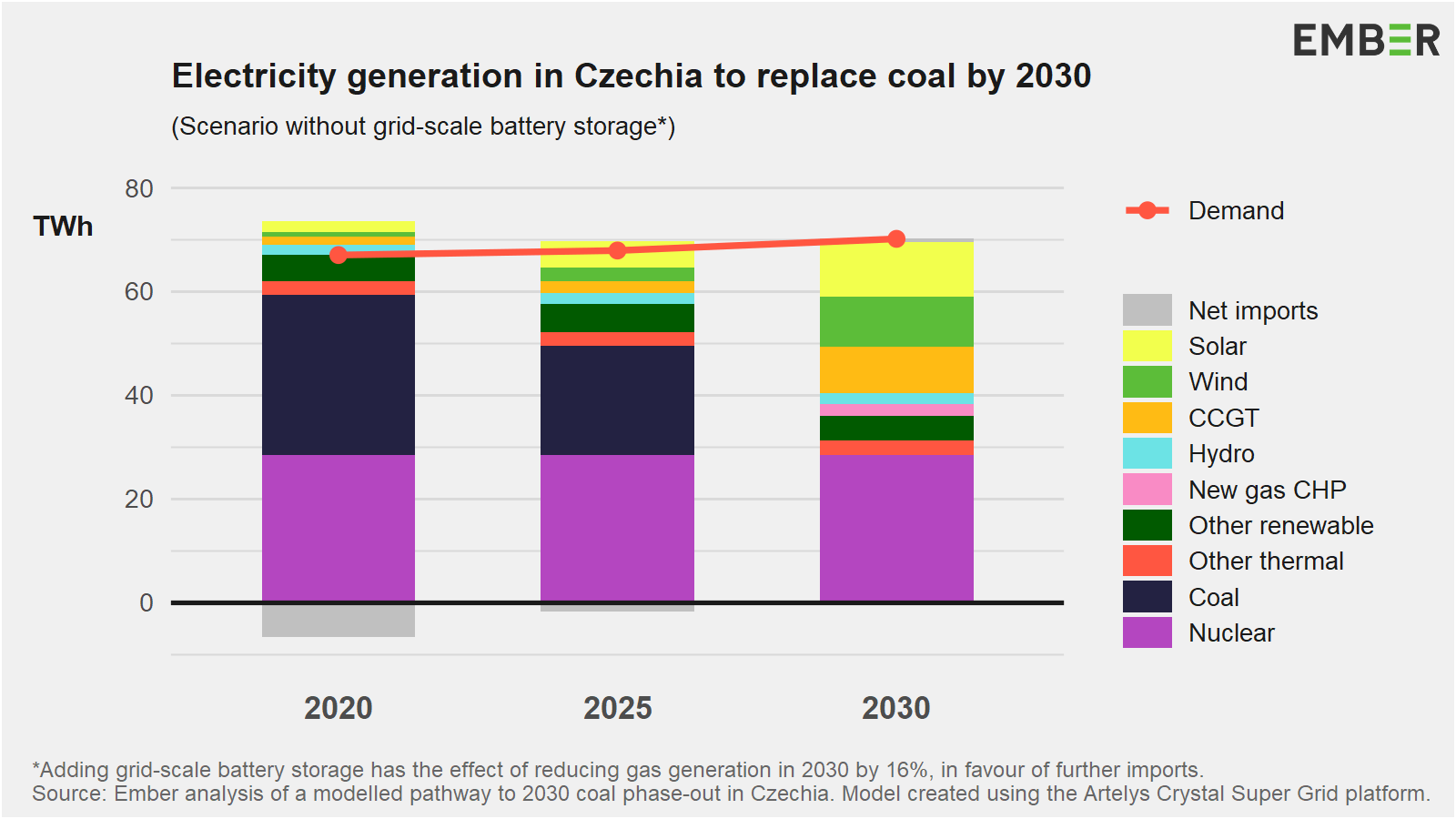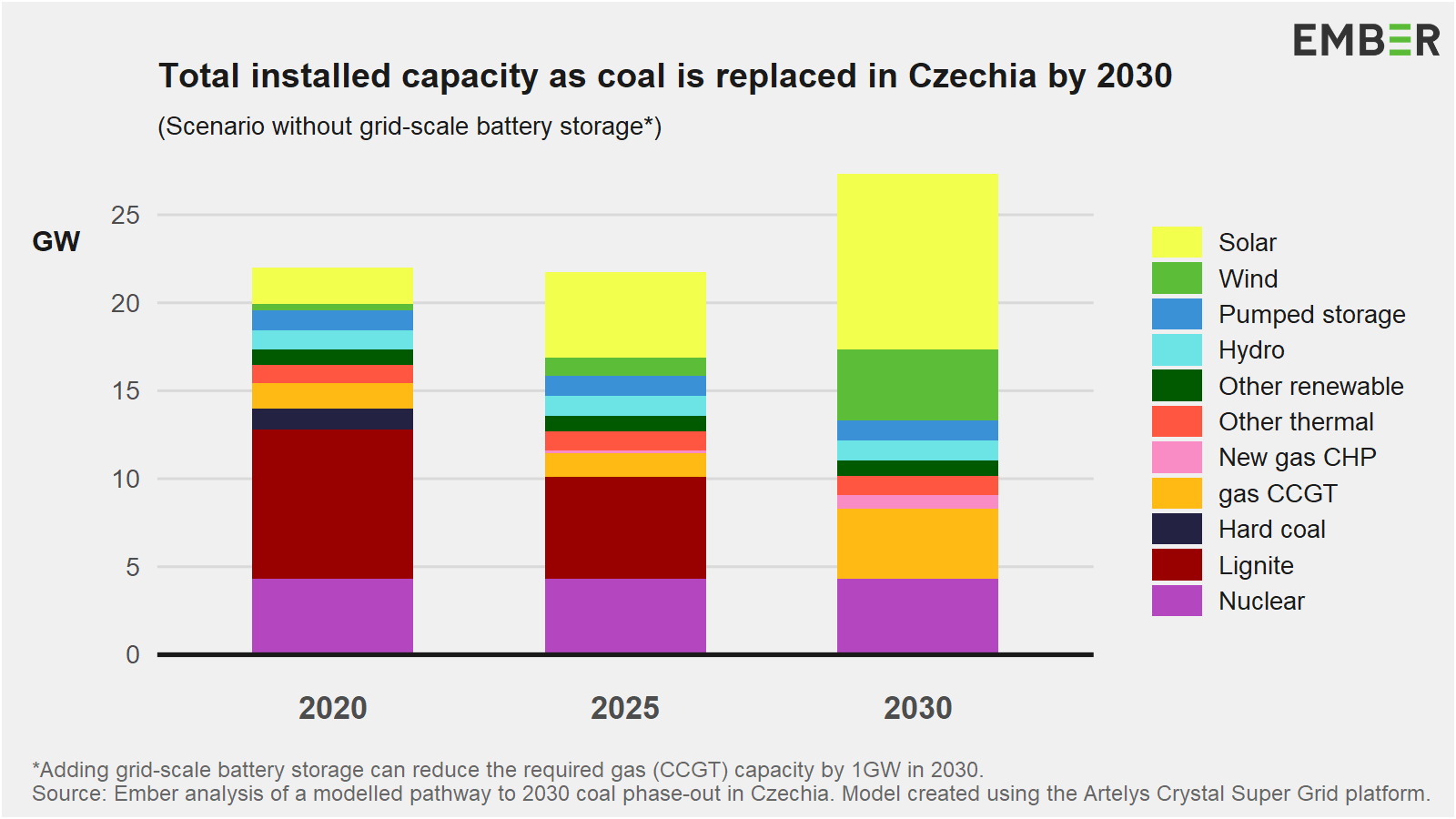About
In 2019 the Czech government convened a coal commission to recommend an end date for coal, with a decision due by the end of 2020. In this context we have modelled a pathway to a coal-free Czechia by 2030. We use hourly power system modelling to show how coal can be replaced in power and large-scale heat generation. Our objective was to investigate the scale and feasibility of changes necessary to achieve a 2030 coal phase-out. We believe the evidence presented should bring 2030 into serious contention for the Czech coal commission.
Modelling was performed using the Artelys Crystal Supergrid platform. This is an established energy modelling tool, frequently used to plan and evaluate European infrastructure development. The Czech power system was modelled as part of an integrated European electricity network. In the model, all Czech coal capacity was required to close by 2030. The generation of power and heat is replaced by an optimised combination of alternatives, at least cost.
Full results can be found in the downloadable reports.
Executive summary
Czechia can phase out coal from electricity and heating by 2030
Energy & Climate Data Analyst, Ember
With ambitious but realistic action, Czechia can phase out coal from electricity and heating by 2030. The least-cost energy pathway modelled by Ember sees Czechia deploying new wind and solar at a speed and scale already achieved by other EU countries, as well as developing a more modern and efficient heating system. A 2030 coal phase-out would invest in Czechia’s future economy and enhance its international reputation as it delivers emissions cuts in alignment with the EU Green Deal and Paris Agreement.

Conclusion
An energy pathway towards 2030 coal phase-out
Phasing out coal in Czechia by 2030 will take ambitious action, but it is possible to complete in the next decade.
The findings of our power system modelling shows how coal can be replaced in power and large-scale heat generation, demonstrating that 2030 coal phase out should be seriously considered by the Czech coal commission.
The lowest cost pathway will mean a strong focus on wind and solar as coal is phased out, with our modelling showing that Czechia could shift towards renewables without curtailing generation by adding 3.7GW onshore wind and 7.9GW solar in the next ten years. This would be supported by a small amount of new dispatchable capacity through small amount of gas generation, made even smaller if grid-scale battery storage is deployed. While wind and solar are economically competitive, policy support is critical to accelerate the shift at the speed needed.
Without an ambitious commitment to renewable sources, Czechia risks replacing on generation of unsustainable assets with another. If coal generation is replaced primarily with fossil gas, not only would this deviate from the lowest cost route, but these new assets would be at significant risk of becoming stranded. As well as coming with higher costs and financial risk, a coal phase-out focused on gas would expose Czech energy security to volatile international markets, due to a lack of domestic gas supplies.
The estimated investments required to deliver a 2030 coal phase-out are significant, but amount to a relatively small fraction of GDP, approximately 0.5% per year. That scale of investment in the power sector would deliver a significant jobs boost of 45,00 direct FTE, far outnumbering the reported 13,700 employed in coal mining in 2018. Large scale investment in wind and solar are the key to delivering that benefit.
On an energy basis, heat generation from large coal plants can be replaced largely with clean alternatives by 2030. These solutions should be urgently explored, with highly efficient heat pumps an especially promising technology.
Action over the next decade will be pivotal for putting Europe on track to achieve net-zero by 2050. This is reflected in moves to strengthen the EU’s emissions target for 2030 from 40% to ‘at least 55%’ reductions. A 2030 coal phase-out would deliver sufficient emissions reductions for Czechia to meet or exceed that 55% target. A political commitment to a 2030 coal phase-out date would show strong intent to embrace this opportunity. It would also place Czechia in a strong position to leverage EU recovery funds to deliver a more sustainable, efficient, and affordable energy system.
Supporting Material
Methodology
Overview
This analysis uses an hourly power system model with least-cost optimisation to simulate electricity and coal CHP heat production in the years 2020, 2025, and 2030. Hourly electricity demand was estimated using real climatic data from three representative years.
In the model, Czechia is integrated into the wider European power network, the evolution is which follows ENTSO-E’s Ten Year Network Development Plan (TYNDP).
Key assumptions
In our modelled pathway, the NECP is taken as a baseline for electricity and heat demand, as well as some non-coal production capacity.
The following modifications are made:
Power capacity: Czech coal capacity (both electricity-only and CHP) was required to fall by 40% by 2025 and 100% by 2030. Technologies with limited scope for development before 2030 were set according to the NECP, i.e., no new nuclear, and only small changes in hydropower (and pumped storage), bioenergy, waste incineration, and interconnection. This meant coal was largely replaced by an optimised combination of solar, wind, and flexible gas generation. We produced an additional scenario to explore the impacts of adding battery storage (equivalent to 20% of solar capacity).
RES limits: We impose upper limits on wind and solar deployment, in an attempt to remain within economic and territorial constraints. Broadly, we assume maximum deployment rates in agreement with expert estimates over the 2020-25 period, but allow acceleration in the second half of the decade. Onshore wind capacity was limited to 1GW by 2025 and 4GW by 2030. The necessary additions over the next 5 years (760MW) are a significant scale-up for Czechia, but other EU countries with similar resource potential are achieving more. According to Eurostat, between 2013-2018 Austria added 1458MW, Belgium 1003MW, and Denmark 872MW. Solar capacity was limited to 4.8GW by 2025 and 10GW by 2030. Between 2009-2011 Czechia added 1.5GW, exceeding the rate required between 2020-2030 to reach the upper limits set.
Heat demand: We use national statistics and projections in the Czech NECP to estimate the shortfall in heat supply as a consequence of phasing-out coal CHP plants, in both the district heating system and dedicated units for own-consumption. In addition to this, we incorporated estimates of additional savings that could be achieved by more ambitious building renovation. These estimates combine to reduce the heat demand in scope for the model by approximately one third, from 60PJ to 40PJ between 2020 and 2030. Current non-coal heat production was assumed to evolve according to the NECP, and was not modelled.
Heat production: Before optimising the replacement of coal CHP heat, we gathered estimates for the potential of waste heat recovery. Subsequently we subtracted 11PJ of heat demand, assuming a baseload production profile. The remaining supply is optimised by the model, which selects between large heat pumps, gas/biomass CHP, and gas/biomass heat-only boilers. Due to uncertainties about the end-user requirements of own-consumers, we required the model to source at least 15PJ from thermal combustion.
Acknowledgements
Designers for Climate
Cover photoiStock kamilpetran
ContributorsArtelys performed model optimisation using the Artelys Crystal Super Grid platform.
Nano Energies (CZ) provided expert consultation on the Czech energy system.







